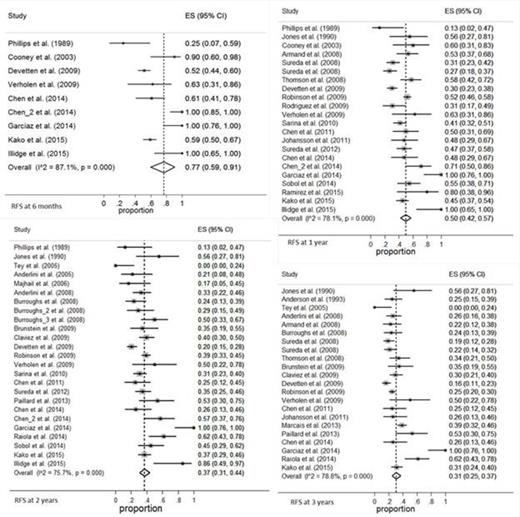Abstract
Background: The availability of multiple active new agents for the treatment of relapsed or refractory Hodgkin lymphoma (HL) has brought into question the role of allogeneic stem cell transplantation (allo-SCT). We performed a meta-analysis of allo-SCT outcomes in patients with HL.
Methods: Medline and Embase were searched for literature published until June 1, 2015. A 5-category scoring system was used for quality assessment: (i) conditioning regimen, (ii) stem cell source, (iii) donor, (iv) GvHD prophylaxis, and (v) pre-SCT disease status. For these scoring factors, studies received a score of 1 if the information was provided in the report and zero otherwise. Primary endpoints were OS and RFS at 6 months, 1 year, 2 years, and 3 years. Secondary endpoints were the cumulative incidence of relapse (CIR) and NRM. Heterogeneity was studied using the Cochran Q statistic. A random effects model was used in proportion meta-analysis. Publication bias was assessed using funnel plots and Egger test. STATA 13 was used for analysis. P <0.05 was considered statistically significant.
Results: 41 series were included (n = 1,831 patients; 13 prospective; 21 multi-center). One study scored 1, two scored 2, one scored 3, nine scored 4, and 28 scored 5 on quality assessment scale. Conditioning was myeloablative (n = 7), reduced-intensity (n = 29), and mixed/unknown (n = 5). Transplants were from an HLA-matched donor in 20 studies, mismatched donor (haploidentical, mismatched unrelated donor, or cord) in 4 studies, and mixed/unknown in others. Median follow-up ranged between 11 and 104 months. There was significant statistical heterogeneity among studies in all outcomes. The pooled estimates (95%CI) for RFS at 1 year and 3 years were 50 (42-57)% and 31 (25-37)%, respectively (Figure 1). The corresponding numbers for OS were 68 (62-74)% and 50 (41-58)%, respectively. The pooled estimates (95%CI) for CIR at 1 year and 3 years were 34 (30-39)% and 46 (40-51)%, respectively. The corresponding numbers for NRM were both 19 (14-24)%. Figure 2 shows reconstructed curves for RFS, OS, CIR, and NRM.
In meta-regression, accrual initiation year in 2000 or later was associated with higher 6-month (P=0.012) and 1-year OS (P=0.046). Pre-SCT CR/PR was associated with higher 2-yeasr OS (P=0.047) and 1-year RFS (P=0.016). Previous auto-SCT was associated with higher 1-year OS (P=0.012), 2-year OS (P=0.040), 6-month RFS (P<0.01), and 1-year RFS (P=0.005), and lower 1-year (P<0.001), 2-year (P=0.037), and 3-year NRM (P=0.007), likely reflecting the fitness of patients who have previously tolerated auto-SCT. None of the studied variables were associated with CIR. There was no significant publication bias with the exception of 2-year NRM (P=0.04) and 2-year OS (P=0.02), where there was a lack of small studies with high NRM and low OS.
Conclusions: While NRM following allo-SCT reaches a plateau at 1 year, relapse continues to occur, reaching a cumulative incidence of 46% at 3 years. RFS and OS outcomes are also disappointing, with no apparent plateau until 3 years. Less than a third of patients are relapse-free and alive at 3 years after allo-SCT. These results from a large meta-analysis argue against the value of allo-SCT in relapsed/refractory HL.
No relevant conflicts of interest to declare.
Author notes
Asterisk with author names denotes non-ASH members.



This feature is available to Subscribers Only
Sign In or Create an Account Close Modal